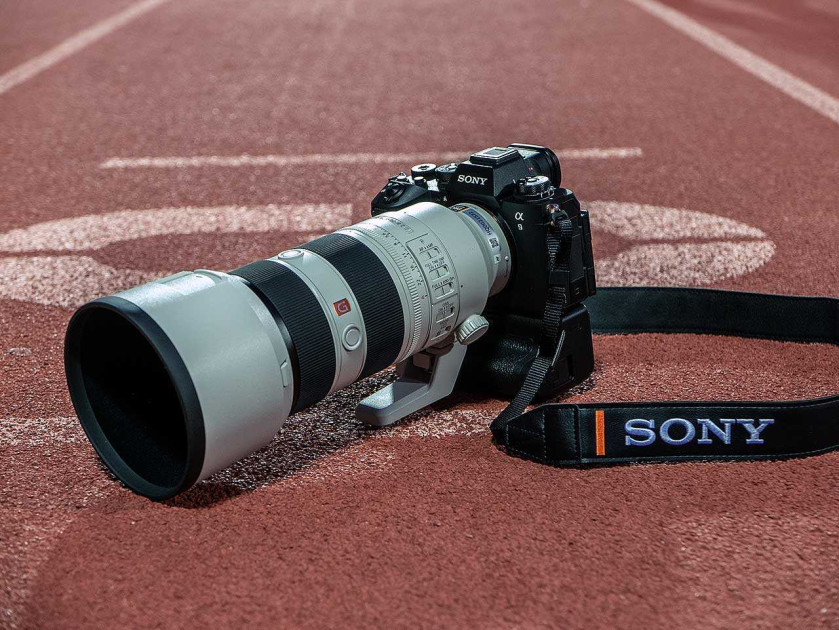
Introduction
The Sony A9 III is a professional full-frame mirrorless camera that’s designed for sports and wildlife photography and photojournalism.
Sony are billing the A9 III as a new milestone in the short but rich history of the Alpha system, as October 16th, 2023 marks the 10th Anniversary of Sony Alpha full-frame mirrorless cameras.
It also represents a significant milestone in the imaging industry, as the A9III is the first ever camera to feature a full-frame global shutter image sensor.
This allows up to 1/80000th shutter speed with no distortion, flash-sync at any shutter speed, flicker-free shooting, and a 120fps blackout-free burst mode.
The ISO range is 250-25600, expandable to 125-51200 for stills, as a characteristic of the global shutter sensor is a higher base ISO speed.
The A9 III has a 240fps EVF with 9.44M dots, 4-axis LCD screen, 8-stops of IBIS, dust and moisture resistance, and dual BIONZ XR processors which provide the latest AI-based Real-time Recognition AF system,
There are special Pre-capture and Continuous Shooting Speed Boost modes, the latter allowing you to select 120fps at the press of a button, if you’re not already shooting in it.
The new Composite Raw shooting mode takes up to 32 images to reduce noise through Sony’s Imaging Edge software, with handheld shooting possible.
For video, there’s 6K oversampling for 4K 60p and 4K 120p without cropping, all distortion-free (no jello effect) in 10-bit 4:2:2 S-log3 / S-Cinetone, with Dynamic Active Mode stabilisation and breathing compensation.
Faster workflow support has been implemented, with clearer voice memos thanks to new mic next to LCD screen, multiple IPTC presets (20) (only 1 preset on A1), and transfer and tagging + remote control tool support.
The Sony Alpha A9 III is available in January 2024 priced at £6100 / $6000 / €7000 body-only in the UK, US and Europe respectively.
There’s also a new VG-C5 vertical grip which is priced at £390 / $400 / €450.
Ease of Use
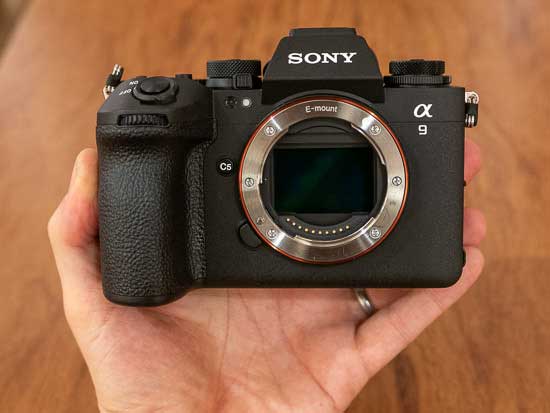
At the heart of the A9 III is a brand new 25.2 megapixel, 35mm full-frame (35.6 x 23.8 mm) Exmor RS CMOS stacked sensor with an optical low pass filter that delivers 24.6 megapixels for stills and 20.3 megapixels for movies, providing comparable resolution to its predecessor.
Much more important than the megapixel count, though, is the fact that the A9 III uses the world’s first ever 35mm full-frame global shutter image sensor.
Rather than reading the sensor line by line, as with all other electronic shutters, a global shutter allows the A9 III to instantly read the entire sensor in one go.
This has a number of important benefits – it virtually eliminates rolling shutter in video, distortion of movement if the subject moves quickly across the frame, and flicker and banding under artificial lights, whilst providing an incredibly high shutter speed of 1/80,000th second.
Also flash-sync is available at any shutter speed, completely eliminating the need for a high-speed flash sync setting and allowing the photographer to overpower the sun and control the background exposure even at midday at base ISO with a high shutter speed, and just use a small, affordable flashgun as a fill-in light.
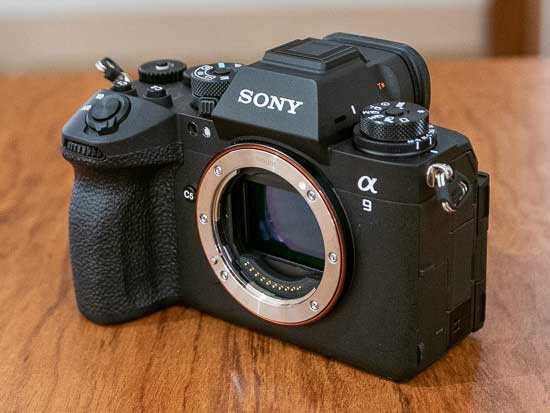
A future firmware upgrade will be required for Sony’s existing F46RM and F60RM2 flashguns to enable 1/80,000th compatibility (at reduced power), but crucially this feature is also available for third-party flashguns too.
Note that for the moment the maximum shutter speed is 1/16,000th second when the A9 III is set to any burst shooting mode, even the Low setting. This will apparently be changed to 1/80,000th sec in March 2024 via a firmware update.
The technological leap to a global electronic shutter means that the A9III completely dispenses with a traditional mechanical shutter, just like the Nikon Z9 and Z8.
So it’s likely that as the global shutter becomes easier and cheaper to produce and slowly trickles down the range, the days of the progressive shutter, be that electronic or mechanical shutter, may be numbered, at least on higher-end cameras.
The A9III has a native ISO range is 250-25600, expandable to 125-51200 for stills, significantly narrower than the A9II which has a range of 100-12000 that is expandable to 50-204800.

Composite Raw Shooting is a brand new mode that takes up to 32 images to create full-resolution images with greatly reduced noise. Handheld shooting is possible in this mode, although you do need to run the images through Sony’s Imaging Edge desktop software to process them.
At first glance the new Mark III iteration of the Sony A9 looks very much like 2019’s Mark II version, which in turn was almost a complete doppelganger of the original A9 from 2017.
So if you were hoping for a Nikon Z9-esque, integrated-grip design on this new Alpha sports camera, then you’ll be disappointed, instead having to make do with buying the optional VG-C5 vertical grip accessory which adds duplicate controls including the new C5 button and two NP-FZ100 batteries.
Sony have definitely taken the cautious approach here, as we can’t imagine too many A9 III owners using it without having the vertical grip fitted, as the camera doesn’t balance at all well without it when used with the longer telephoto lenses like the equally new FE 300mm F2.8.
On the other hand, it does allow for more flexibility for those times when you might want to use the A9 III with smaller lenses and you don’t want a big, imposing camera, where it feels just like every other Alpha full-framer that has been released in the last few years.
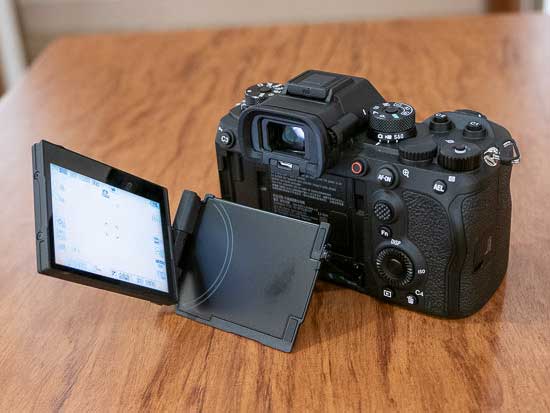
That’s not quite true, though, as Sony have significantly tweaked the design of the A9 III’s own hand-grip, which is larger than its predecessors and perhaps more importantly spaced further away from the lens mount, which allows for more room for your fingers to curl around the grip without touching the attached lens.
While this does necessitate the creation and subsequent purchase of yet another vertical grip, it is a subtle but very welcome improvement.
It also means that the A9 III is wider and therefore heavier than its predecessor, measuring 136.1 x 96.9 x 82.9 mm and weighing 702 g / 1 lb 8.8 oz, versus 128.9 x 96.4 x 77.5 mm and 678 g / 1.49 lb on the Mark II.
In the seemingly ever-constant pursuit of things being smaller and lighter, though, this departure from the sizing norm is a breath of fresh air given that it makes the A9III significantly easier to use.
Other subtle changes include moving the shutter button slightly forward to better facilitate its release, and a new custom button (C5) on the front of the camera which by default is assigned to the new Continuous Speed Shooting Boost function.
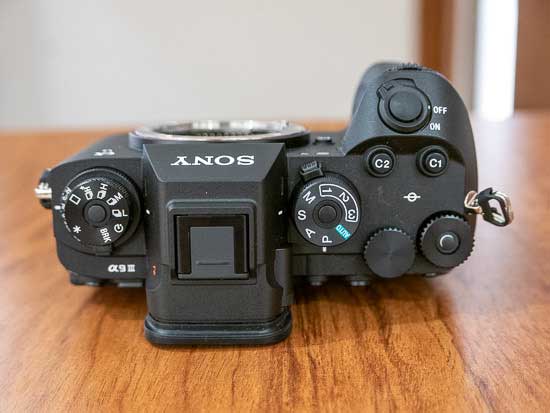
This function provides an easy way to engage the headline-grabbing 120fps burst mode – yes, 120 frames per second for 1.6 seconds at full 24 megapixel resolution for both JPEG and 14-bit Raw formats with full-time AF/AE! – at the press of a button, if you’re not already shooting at 120fps.
So Sony have recognised the fact that 120fps is actually too fast for the majority of situations and come up with a way of using it only at the moment that it’s most needed.
The only drawback from an operational point of view is that you need to hold the button down whilst you’re shooting, which is a little awkward in practice – but then you only need to do it for a split-second.
Commendably, the 120fps burst mode isn’t dependent on using a specific speed-rated memory card. You can select it when using any CFexpress Type A or SD card, with the type/speed of card affecting how quickly the buffer is cleared rather than limiting the frame rate.
You will need to make sure that your lenses are compatible with the 120fps mode with AF/AE tracking – Sony have provided a handy list here.
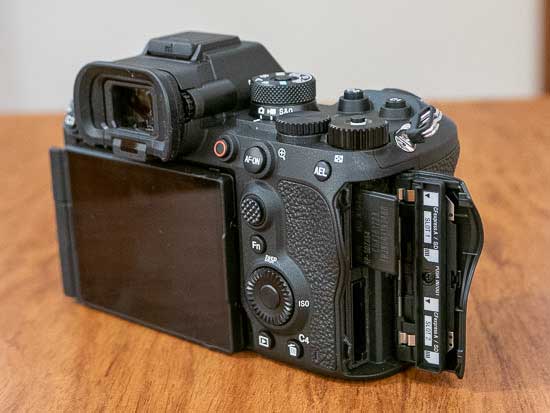
Another new hardware feature is the ability to deactivate the drive mode dial and assign it to the Function menu or a custom button, useful in the dark or if the camera is being protected in some way from the elements.
Pre-capture is a feature that we’ve seen before on other manufacturers’ cameras, but is a first for Sony. When activated, up to 120 frames per second are temporarily stored while the shutter button is half-pressed, and up to 1 second before can be captured once the shutter is fully pressed, providing a degree of leniency for fast-moving action.
Other hardware improvements on the Mark III A9 have largely been imported from other Alpha models, but are no less noteworthy.
These include the 3.2-inch, 2095K dot resolution, 4-axis LCD screen from the A7R V and which is unique to Sony, which can be flipped out to the side, rotated to the front, folded against the back of the camera to help protect it, and set to many other positions in-between.
It makes the camera ever-so-slightly thicker than its predecessor, but more than makes up for that with its incredible versatility.
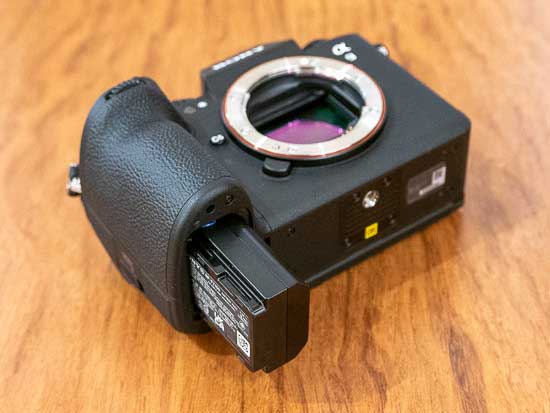
In terms of touch-screen functionality, the new Alpha A7R V thankfully follows in the footsteps of the A7R V, inheriting the same menu structure and upgraded touch control, rather than the crippled touchscreen and more complex menu system of earlier Alpha models.
It also has the same very impressive 9.44M-dot OLED Quad-XGA electronic viewfinder with 0.90x magnification, again taken from the A7R V, although this one now has a refresh rate of up to 240fps in the new Higher mode, rather than 120fps, although the resolution is reduced at 240fps.
Note that the 120fps High frame rate is now compatible with the high quality display setting, something that is not possible on the flagship Alpha 1.
Just like the A1, the A9III has a pair of Bionz XR processors, which among other things powers the frankly amazing AI-based Real-time Recognition AF system.
The Sony A9 III’s AF system has 759 on-sensor phase detection points that cover approximately 95% of the image area and it can focus down to -5EV, just short of the the -6EV achieved by the A7S III and better than the A1’s -4EV rating.

The A9 III can recognise a human via its pose as well as its eye and face. So if the person’s head is turned away from the camera, it will still accurately detect the subject as human based on its AI deep learning.
It can also recognise animals, birds, insects, airplanes, and cars/trains. In the latter category, it is now capable of focusing on helmets, it can recognise the eyes of some grazing and small animals, and more easily pinpoint the eyes of a variety of bird types as well as recognising bird bodies.
A new Animal/Bird setting eliminates the need to switch between those settings to shoot animals or birds, although we’d still like an Auto Subject recognition mode, as featured on some rival cameras.
Thanks to a newly redesigned stabilisation unit previously debuted on the A7R V, the A9 III now offers up to 8 stops of in-body stabilisation, up from 5.5 stops on the A9 II, making it the joint-most capable Alpha camera in this regard.
The A9 III also benefits from having a special Active Mode that increases stabilization for hand-held movie shooting by using the BIONZ XR processors.
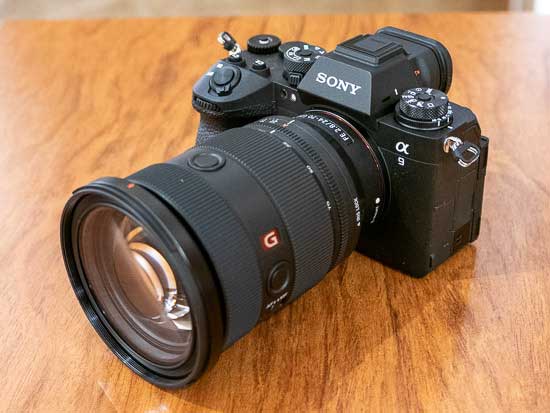
Providing even more compensation at the expense of an increased crop factor is the new Dynamic Active Mode, which improves the stabilisation by more than 30% over the existing Active Mode.
The A9 III utilises 6K oversampling for 4K 60p video, and it also supports 4K 120p without cropping for the first time in an Alpha body, both distortion-free (no jello effect) thanks to the global shutter, recorded internally using All-I encoding at 10-bit 4:2:2 quality.
It can output 16-bit Raw video over HDMI to an external recorder and supports both S-Log3 (base ISO 2000) and the same S-Cinetone (base IOS 320) colour matrix from the VENICE, FX6, and other Cinema Line cameras, making it easier to integrate into a professional workflow when using different types of camera.
Both of the memory card slots can be used for either SD UHS-I/II compliant memory cards or faster CFexpress Type A cards, just like the Alpha 1 and A7R V although those Type A cards are still prohibitively expensive.
Sample Images
This is a selection of sample images from the Sony A9 III camera, which were all taken using the 24.6 megapixel Extra Fine JPEG setting. The thumbnails below link to the full-sized versions, which have not been altered in any way.
Product Images

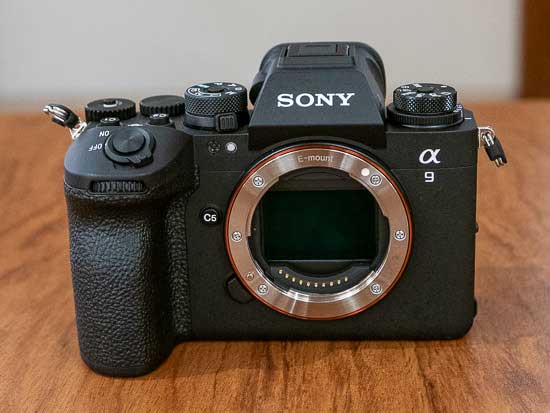
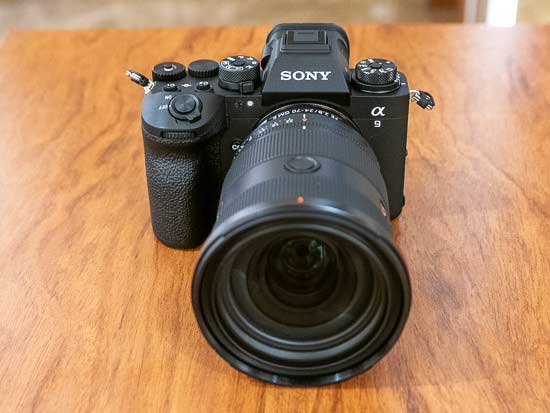
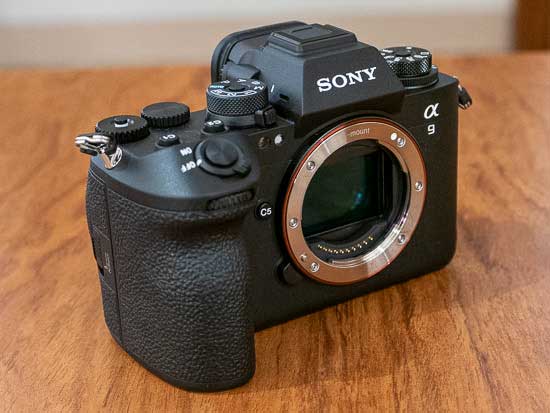
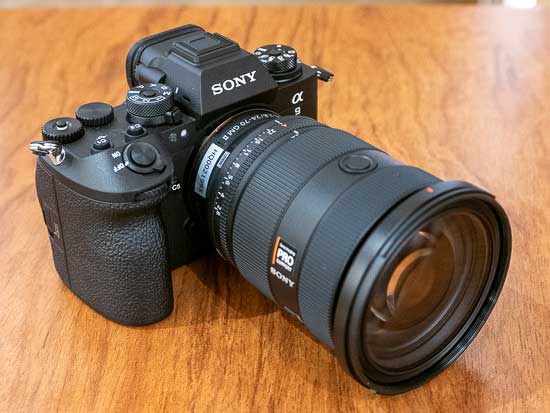


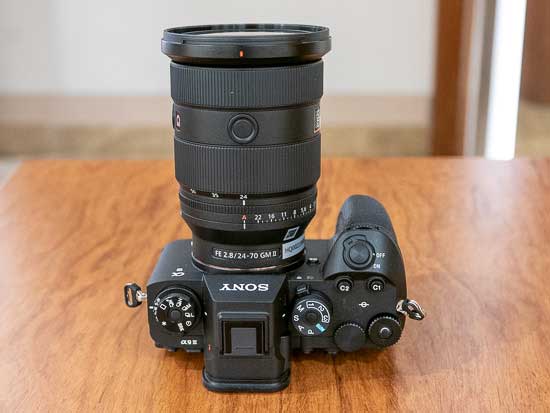
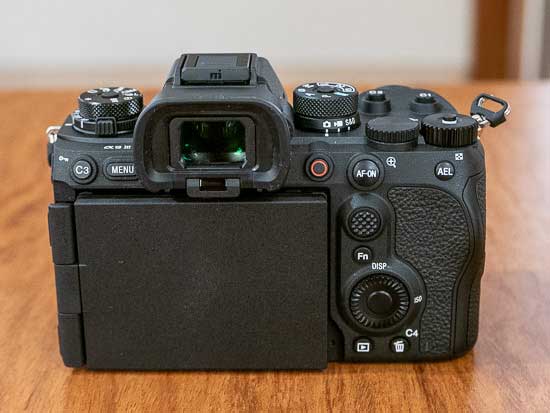
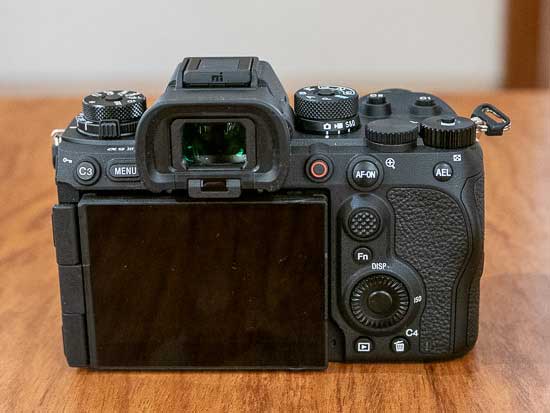

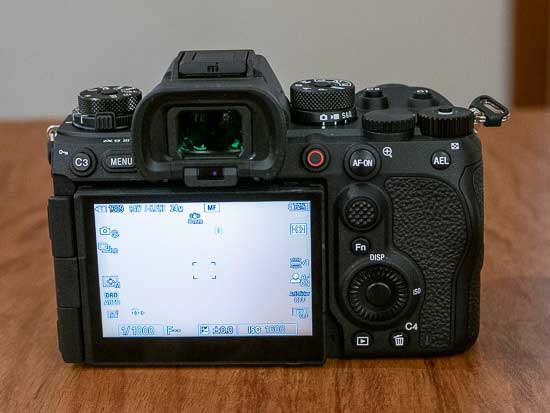

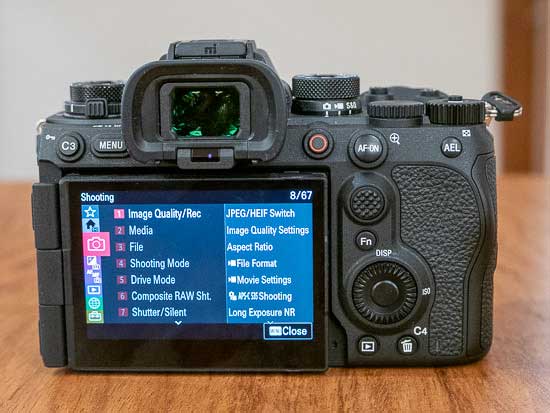
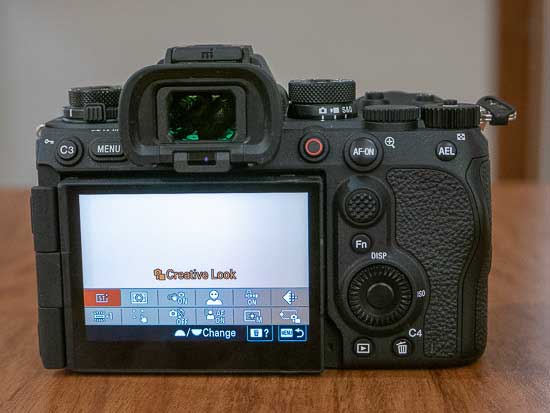
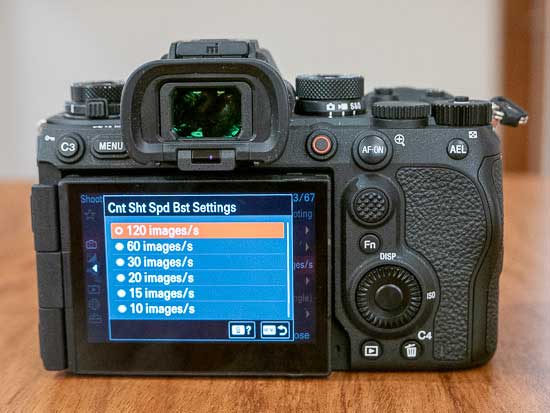
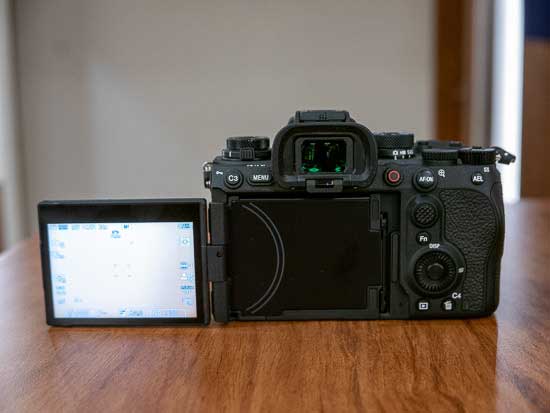
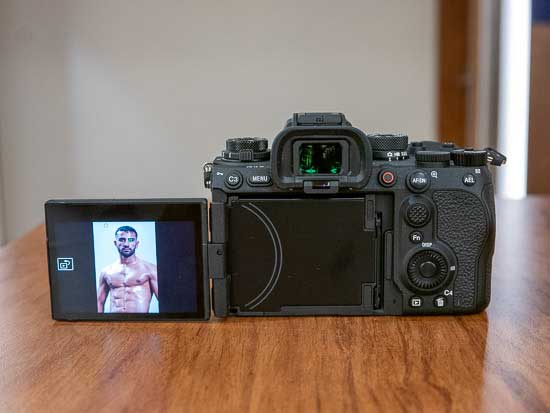
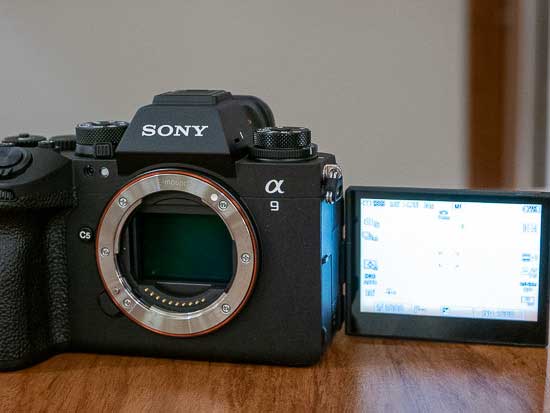

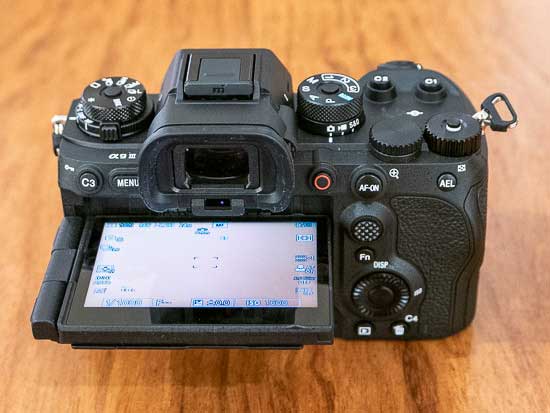





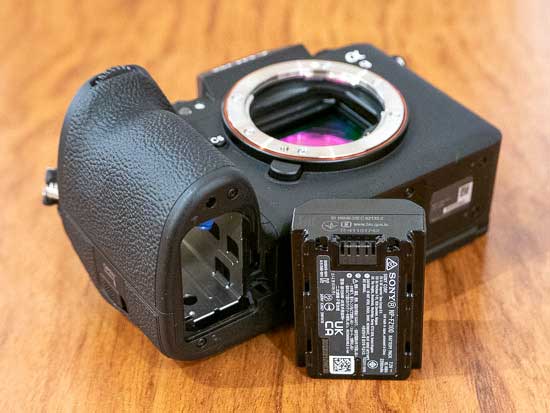
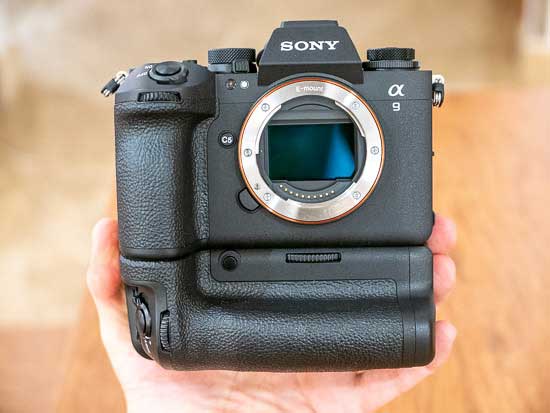

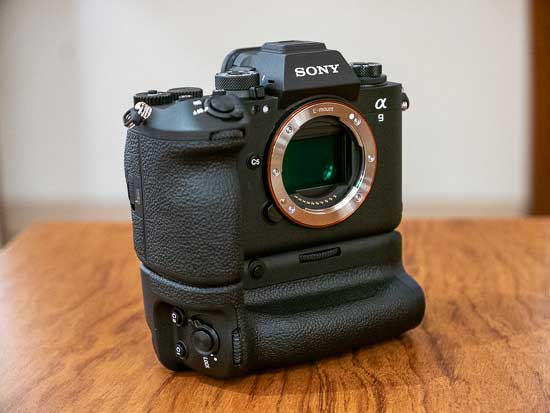
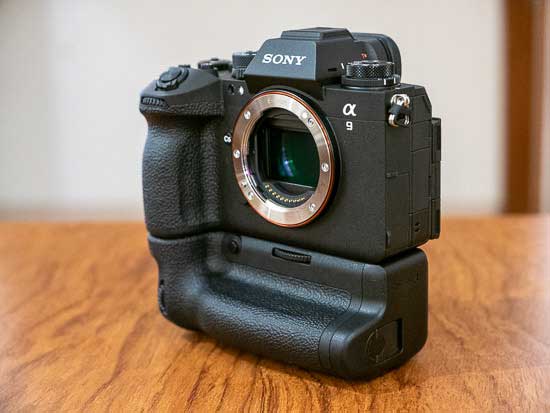
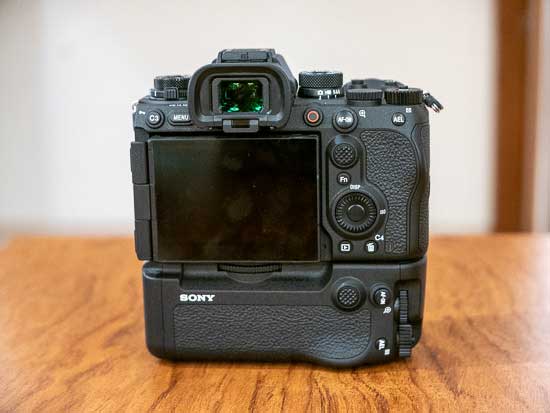
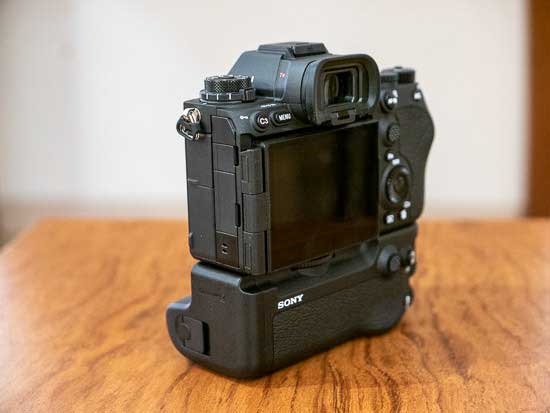
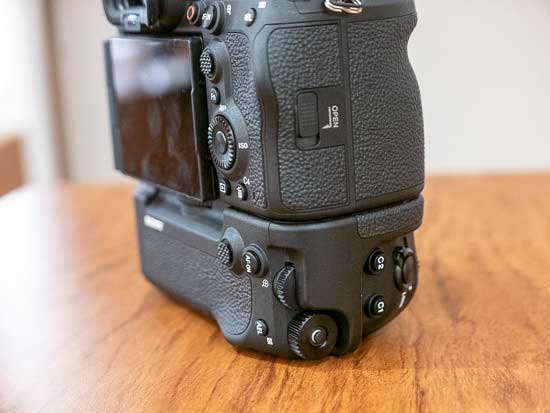
Main Rivals
Listed below are some of the rivals of the Sony A9 III.
The Canon EOS R3 is a professional full-frame mirrorless camera for sports and action photographers that features a 24 megapixel stacked BSI sensor, 6K/60p Raw and 4K/120p video recording, 30fps burst shooting, eye-control autofocusing and a dual-grip design. Read our in-depth Canon R3 review complete with full-size sample photos and videos to find out just what the all-action R3 is capable of…

The X-H2S is the fastest, most capable APS-C sensor camera that Fujifilm have ever released, but it’s also by far the most expensive. Find out exactly what this new flagship camera is capable of and who it’s aimed at by reading our complete Fuji XH2S review complete with full-size JPEG, Raw and video samples.

As the spiritual successor to the popular D850 DSLR, the new Z8 full-frame mirrorless camera could turn out to be one of the most important products that Nikon have ever released. Read our in-depth Nikon Z8 review, complete with full-size sample photos and videos, to find out more about this mirrorless marvel…

The Nikon Z9 is a professional level, full-frame mirrorless camera for photographers and videographers that features a 45 megapixel stacked BSI sensor, 8K/30p and 4K/120p video recording, 30fps burst shooting and a dual-grip design. Read our in-depth Nikon Z9 review complete with full-size sample photos and videos to find out just what this flagship camera is capable of…

The new OM-1 flagship is both the last ever Olympus camera and the first ever OM System camera. Confused? Well no need to worry, as we take an in-depth look at what this new Micro Four Thirds flagship has to offer in our OM System OM-1 review, complete with full-size sample photos and videos…

The Sony Alpha 1 camera, or Sony A1 for short, is the best camera that Sony have ever released, and currently the best all-round camera on the market. It’s also one of the most expensive, so read our in-depth Sony A1 review complete with full-size sample JPEG and Raw photos and movies to find out if it’s truly the One for you…

If you’re a professional sports photographer or photojournalist, there have traditionally only been two camera series worth considering, with the latest examples being the Canon EOS 1D X II and the Nikon D5. Two years ago Sony released the Alpha A9, which was specifically designed to take on those two cameras, and now they’re back, just in time for the Olympics, with the improved A9 II. Read our review to find out exactly what the new Sony Alpha A9 Mark II offers…
Specifications
General
- CAMERA TYPE
- Interchangeable lens digital camera
- LENS MOUNT
- E-mount
Camera Section
- SENSOR TYPE
- 35mm full frame (35.6 x 23.8 mm), Exmor RS CMOS sensor
- NUMBER OF PIXELS (TOTAL)
- Approx. 25.2 megapixels
- NUMBER OF PIXELS (EFFECTIVE)
- Still images: Approx. 24.6 megapixels max.,Movies: Approx. 20.3 megapixels max.
- OPTICAL LOW PASS FILTER
- Yes
- COLOR TEMPERATURE RANGE
- 2500 K – 9900 K
Image Sensor
- ANTI-DUST SYSTEM
- Yes
Recording (still images)
- RECORDING FORMAT
- JPEG (DCF Ver. 2.0, Exif Ver. 2.32, MPF Baseline compliant), HEIF (MPEG-A MIAF compliant), RAW (Sony ARW 5.0 format compliant)
- IMAGE SIZE (PIXELS) [3:2]
- 35mm full frame L: 6000 x 4000 (24 M), M: 3936 x 2632 (10 M), S: 3008 x 2000 (6.0 M)
Recording (movie)
- VIDEO COMPRESSION
- XAVC S: MPEG-4 AVC/H.264, XAVC HS: MPEG-H HEVC/H.265
- AUDIO RECORDING FORMAT
- LPCM 2ch (48 kHz 16 bit), LPCM 2ch (48 kHz 24 bit), LPCM 4ch (48 kHz 24 bit)
Recording system (movie)
- MOVIE RECORDING FORMAT (XAVC HS 4K)
- 3840 x 2160 (4:2:0, 10bit) (Approx.):119.88p (200Mbps),3840 x 2160 (4:2:0, 10bit) (Approx.):100p (200Mbps),3840 x 2160 (4:2:0, 10bit) (Approx.):59.94p (150Mbps / 75Mbps / 45Mbps),3840 x 2160 (4:2:0, 10bit) (Approx.):50p (150Mbps / 75Mbps / 45Mbps),3840 x 2160 (4:2:0, 10bit) (Approx.):23.98p (100Mbps / 50Mbps / 30Mbps),3840 x 2160 (4:2:2, 10bit) (Approx.):119.88p (280Mbps),3840 x 2160 (4:2:2, 10bit) (Approx.):100p (280Mbps),3840 x 2160 (4:2:2, 10bit) (Approx.):59.94p (200Mbps / 100Mbps),3840 x 2160 (4:2:2, 10bit) (Approx.):50p (200Mbps / 100Mbps),3840 x 2160 (4:2:2, 10bit) (Approx.):23.98p (100Mbps / 50Mbps)
- MOVIE RECORDING FORMAT (XAVC S 4K)
- 3840 x 2160 (4:2:0, 8bit) (Approx.):119.88p (200Mbps),3840 x 2160 (4:2:0, 8bit) (Approx.):100p (200Mbps),3840 x 2160 (4:2:0, 8bit) (Approx.):59.94p (150Mbps),3840 x 2160 (4:2:0, 8bit) (Approx.):50p (150Mbps),3840 x 2160 (4:2:0, 8bit) (Approx.):29.97p (100Mbps / 60Mbps),3840 x 2160 (4:2:0, 8bit) (Approx.):25p (100Mbps / 60Mbps),3840 x 2160 (4:2:0, 8bit) (Approx.):23.98p (100Mbps / 60Mbps),3840 x 2160 (4:2:2, 10bit) (Approx.):119.88p (280Mbps),3840 x 2160 (4:2:2, 10bit) (Approx.):100p (280Mbps),3840 x 2160 (4:2:2, 10bit) (Approx.):59.94p (200Mbps),3840 x 2160 (4:2:2, 10bit) (Approx.):50p (200Mbps),3840 x 2160 (4:2:2, 10bit) (Approx.):29.97p (140Mbps),3840 x 2160 (4:2:2, 10bit) (Approx.):25p (140Mbps),3840 x 2160 (4:2:2, 10bit) (Approx.):23.98p (100Mbps)
- MOVIE RECORDING FORMAT (XAVC S HD)
- 1920 x 1080 (4:2:0, 8bit) (Approx.):119.88p (100Mbps / 60Mbps),1920 x 1080 (4:2:0, 8bit) (Approx.):100p (100Mbps / 60Mbps),1920 x 1080 (4:2:0, 8bit) (Approx.):59.94p (50Mbps / 25Mbps),1920 x 1080 (4:2:0, 8bit) (Approx.):50p (50Mbps / 25Mbps),1920 x 1080 (4:2:0, 8bit) (Approx.):29.97p (50Mbps / 16Mbps),1920 x 1080 (4:2:0, 8bit) (Approx.):25p (50Mbps / 16Mbps),1920 x 1080 (4:2:0, 8bit) (Approx.):23.98p (50Mbps),1920 x 1080 (4:2:2, 10bit) (Approx.):59.94p (50Mbps),1920 x 1080 (4:2:2, 10bit) (Approx.):50p (50Mbps),1920 x 1080 (4:2:2, 10bit) (Approx.):29.97p (50Mbps),1920 x 1080 (4:2:2, 10bit) (Approx.):25p (50Mbps),1920 x 1080 (4:2:2, 10bit) (Approx.):23.98p (50Mbps)
- MOVIE RECORDING FORMAT (XAVC S-I 4K)
- 3840 x 2160 (4:2:2, 10bit) (Approx.):59.94p (600Mbps),3840 x 2160 (4:2:2, 10bit) (Approx.):50p (500Mbps),3840 x 2160 (4:2:2, 10bit) (Approx.):29.97p (300Mbps),3840 x 2160 (4:2:2, 10bit) (Approx.):25p (250Mbps),3840 x 2160 (4:2:2, 10bit) (Approx.):23.98p (240Mbps)
- MOVIE RECORDING FORMAT (XAVC S-I HD)
- 1920 x 1080 (4:2:2, 10bit) (Approx.):59.94p (222Mbps),1920 x 1080 (4:2:2, 10bit) (Approx.):50p (185Mbps),1920 x 1080 (4:2:2, 10bit) (Approx.):29.97p (111Mbps),1920 x 1080 (4:2:2, 10bit) (Approx.):25p (93Mbps),1920 x 1080 (4:2:2, 10bit) (Approx.):23.98p (89Mbps)
Movie Functions
- SLOW & QUICK MOTION (SHOOTING FRAME RATE)
- Yes
- PROXY RECORDING
- Yes
- TC / UB
- Yes
- RAW OUTPUT
- Yes (HDMI)
Recording System
- MEMORY CARD SLOT
- SLOT1: Multi slot for SD (UHS-I/II compliant) memory card / CFexpress Type A card, SLOT2: Multi slot for SD (UHS-I/II compliant) memory card / CFexpress Type A card
Focus System
- FOCUS TYPE
- Fast Hybrid AF (phase-detection AF / contrast-detection AF)
- FOCUS POINT
- Still images: Max. 759 points (phase-detection AF), Movies: Max. 627 points (phase-detection AF)
- FOCUS SENSITIVITY RANGE
- EV-5 to EV20 (ISO100 equivalent with F2.0 lens attached)
- RECOGNITION TARGET (STILL IMAGES)
- Human, Animal, Bird, Insect, Car, Train, Airplane
- RECOGNITION TARGET (MOVIES)
- Human, Animal, Bird, Insect, Car, Train, Airplane
- OTHER FEATURES
- AF Level for Crossing (Still), AF Track for Speed Change (Still), AF Subj. Shift Sensitivity (Movie), AF Transition Speed (Movie), Switch V/H AF Area, AF Area Regist., Circ. of Focus Point, Focus Map (Movie), AF Assist (Movie)
- AF ILLUMINATOR
- Yes (with Built-in LED type)
Exposure Control
- METERING TYPE
- 1200-zone evaluative metering
- METERING SENSITIVITY
- EV-5 to EV17 (ISO100 equivalent with F2.0 lens attached)
- EXPOSURE COMPENSATION
- +/- 5.0 EV (1/3 EV, 1/2 EV steps selectable)
- ISO SENSITIVITY
- Still images: ISO 250 – 25600 (expandable to ISO 125 – 51200), AUTO (ISO 250 – 12800, selectable lower limit and upper limit), Movies: ISO 250 – 25600 equivalent, AUTO (ISO 250 – 12800, selectable lower limit and upper limit)
- ANTI-FLICKER SHOOT.
- Yes
Viewfinder
- TYPE
- 1.6 cm (0.64 type) electronic viewfinder (Quad-XGA OLED)
- NUMBER OF DOTS
- 9 437 184 dots
- MAGNIFICATION
- Approx. 0.90x (with 50 mm lens at infinity, -1 m-1)
- DIOPTRE
- -4.0 to +3.0 m-1
- EYE POINT
- Approx. 25 mm from the eyepiece lens, 21 mm from the eyepiece frame at -1 m-1 (CIPA standard)
- FINDER FRAME RATE SELECTION
- NTSC mode: STD 60fps / HI 120fps / HIGHER 240fps, PAL mode: STD 50fps / HI 100fps / HIGHER 200fps
LCD Screen
- MONITOR TYPE
- 8.0 cm (3.2-type) type TFT
- TOUCH PANEL
- Yes
- NUMBER OF DOTS
- 2 095 104 dots
- ADJUSTABLE ANGLE
- Opening Angles (approx.): Up 98 °, down 40 °, side 180 °, rotation 270 °
Other Features
- OTHER FEATURES
- Soft Skin Effect, Creative Look, Custom function, Picture Profile, Time-lapse, Auto Framing, Pre-Capture, Continuous Shooting Speed Boost, NR Shooting
- CLEAR IMAGE ZOOM (STILL IMAGES)
- Approx. 2x
- CLEAR IMAGE ZOOM (MOVIES)
- Approx. 1.5x (4K), Approx. 2x (HD)
Shutter
- SHUTTER TYPE
- Electronic shutter
- SHUTTER SPEED
- Still images: 1/80000 to 30 s, Bulb, Movies: 1/8000 to 1 s
- FLASH SYNC. SPEED
- 1/80000 s, 1/500 s
Image Stabilization
- TYPE
- Image sensor-shift mechanism with 5-axis compensation (compensation depends on lens specifications)
- COMPENSATION EFFECT
- 8.0 stops (based on CIPA standard. Pitch/yaw shake only. With FE 50mm F1.2 GM lens mounted. Long exposure NR off.)
- MODE
- Still images: On / Off, Movie: Dynamic active / Active / Standard / Off
Flash
- TYPE
- –
- CONTROL
- Pre-flash TTL
- FLASH COMPENSATION
- +/- 3.0 EV (switchable between 1/3 and 1/2 EV steps)
- EXTERNAL FLASH COMPATIBILITY
- Sony α System Flash compatible with Multi Interface Shoe, attach the shoe adaptor for flash compatible with Auto-lock accessory shoe
Drive
- CONTINUOUS DRIVE SPEED (APPROX. MAX.)
- Hi+: 120 fps
Playback
- MODES
- Enlarged display mode, Protect, Rating, Shot Mark (Movie), Divider Frame, Crop, Photo Capture
Accessibility
- FUNCTIONS
- Screen Reader, Focus Magnifier, Focus Map (Movie), Peaking Display, Subject Recognition in AF, Touch Focus, Touch Tracking, Touch Shutter, Touch AE, Multi-angle LCD screen, Custom function
Interface
- PC INTERFACE
- Mass-storage / MTP
- MULTI / MICRO USB TERMINAL
- Yes
- USB TYPE-C TERMINAL
- Yes (SuperSpeed USB 5 Gbps (USB 3.2) compatible)
- NFC
- –
- SYNC TERMINAL
- Yes
- WIRELESS LAN(BUILT-IN)
- Yes (Wi-Fi Compatible, IEEE 802.11a/b/g/n/ac (2.4 GHz band/5 GHz band))
- BLUETOOTH
- Yes (Bluetooth Standard Ver. 5.0 (2.4 GHz band))
- HDMI OUTPUT
- HDMI connector (Type-A), 3840 x 2160 (30p / 25p / 24p) / 1920 x 1080 (60p / 50p / 24p) / 1920 x 1080 (60i / 50i), YCbCr 4:2:2 8bit / RGB 8bit, 4672 x 2628 (59.94p / 29.97p / 23.98p) , Raw 16bit
- MULTI INTERFACE SHOE
- Yes (with Digital Audio Interface)
- MIC TERMINAL
- Yes (3.5 mm Stereo minijack)
- HEADPHONE TERMINAL
- Yes (3.5 mm Stereo minijack)
- REMOTE CONTROL (WIRELESS)
- Yes (Bluetooth remote control)
- LAN TERMINAL
- Yes (1000BASE-T, 100BASE-TX, 10BASE-T)
- FUNCTIONS
- FTP Transfer Func.(Wired LAN, USB Tethering, Wi-Fi), Send to smartphone, Remote control via smartphone, PC Remote
USB Streaming
- VIDEO DATA FORMAT
- MJPEG,YUV420
- VIDEO RESOLUTION
- 3840 x 2160 (15p / 30p),3840 x 2160 (12.5p / 25p),1920 x 1080 (30p / 60p),1920 x 1080 (25p / 50p),1280 x 720 (30p),1280 x 720 (25p)
- AUDIO DATA FORMAT
- LPCM 2ch (16bit 48 kHz)
Audio
- MICROPHONE
- Built-in, stereo, Built-in, voice memo
- SPEAKER
- Built-in, monaural
Lens Compensation
- SETTING
- Shading, Chromatic Aberration, Distortion, Breathing (Movie)
Power
- SUPPLIED BATTERY
- One rechargeable battery pack NP-FZ100
- BATTERY LIFE (STILL IMAGES)
- Approx. 400 shots (Viewfinder) / Approx. 530 shots (LCD monitor) (CIPA standard)
- BATTERY LIFE (MOVIE, ACTUAL RECORDING)
- Approx. 90 min (Viewfinder) / Approx. 95 min (LCD monitor) (CIPA standard)
- BATTERY LIFE (MOVIE, CONTINUOUS RECORDING)
- Approx. 145 min (Viewfinder) / Approx. 150 min (LCD monitor) (CIPA standard)
- INTERNAL BATTERY CHARGE
- Yes (Available with USB Type-C Terminal. USB Power Delivery compatible)
- USB POWER SUPPLY
- Yes (Available with USB Type-C Terminal. USB Power Delivery compatible)
- POWER CONSUMPTION WITH LCD SCREEN
- Still images: Approx. 4.8 W (with FE 28-70mm F3.5-5.6 OSS lens attached), Movies: Approx. 6.8 W (with FE 28-70mm F3.5-5.6 OSS lens attached)
Weight
- BODY ONLY
- Approx. 617 g / Approx. 1 lb 5.8 oz
Weight
- WEIGHT (WITH BATTERY AND MEMORY CARD INCLUDED)
- Approx. 702 g / Approx. 1 lb 8.8 oz
Size & Weight
- DIMENSIONS (W X H X D)
- Approx. 136.1 x 96.9 x 82.9 mm, Approx. 136.1 x 96.9 x 72.8 mm (from grip to monitor)/Approx. 5 3/8 x 3 7/8 x 3 3/8 inches, Approx. 5 3/8 x 3 7/8 x 2 7/8 inches (from grip to monitor)
Operating temparature
- OPERATING TEMPERATURE
- 0 – 40 ℃ / 32 – 104 °F
Supplied Accessory
- WHAT’S IN THE BOX
- Rechargeable Battery NP-FZ100, Battery Charger BC-QZ1, Power cord,Cable Protector, Shoulder strap, Body cap, Accessory shoe cap, Eyepiece cup
Your Comments
Credit : Source Post






